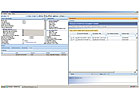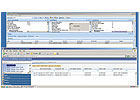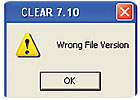
An
enterprisewide resource planning (ERP) inventory screen with
non-conformances/issues is displayed. Within this inventory screen is a second
program displaying a list of controlled documents connected to the inventory
item, which are being drawn directly from a QA system. Furthermore, the prime
data has been entered into this system by the ERP operator without any
additional knowledge or effort. The ERP operator can see the progress of a CAPA
without having to go to a different system. Source: Proquis
Enterprisewide solutions were once the prerogative of large corporations and out of bounds to most average businesses. Mainframe systems and green screens are long gone, with new server farms providing corporatewide data recording and analysis. This allows real-time tracking of finance and manufacturing. Rapid developments in computing hardware and software have brought the advantages once gained only by major corporations within the reach of anyone in business, even sole traders.
During the past few years, the move to corporate solutions from isolated PCs has become a reality for many companies primarily because communication technology now makes this an effective, yet low-cost possibility.
Enterprisewide software can be broadly divided into two basic groups: locally installed and server systems.
Locally installed system software, such as Windows7/Windows XP, Server 2008, SQL2008, Office 2003 and Internet Explorer, is local to the workstation or server.
Many companies experience difficulties when purchasing new IT equipment because the newer software versions are not always compatible with existing office systems. Even if they are not connected, these enterprisewide solutions must be kept uniform to avoid failures in opening data files. The best course is to upgrade across the entire enterprise, but only after extensive testing.
In a server system, the software is installed on the server and used by all workstations corporatewide, storing data into a central, combined repository rather than having it individually installed on their machines. Data stored into a central combined repository makes backup easier to maintain.
With advancements in technology, the job of traditional mainframe computer systems is now available to any business delivered as sophisticated Web applications through the user’s browser. Similar to accessing data through an intranet interface, these applications sit behind a highly secure firewall.
The main advantages of such systems are that they can be used to provide corporatewide solutions without compromising security. The explosion of Internet use by the public, which of course includes staff, means that they will find the interface familiar and comfortable.

Databases
and applications are being constructed in a way that allows real-time
connection, or at worst, timed update between systems. It also permits data
from one system to be displayed within the screens of another system. From a
user’s perspective, it seems as though only one application is running. This
allows the user to do the job in the simplest way with single entry,
eliminating gaps and ensuring management gets a complete picture. Source:
Proquis
Challenges and Risks
Today’s users can browse the Internet, communicate through e-mail or online conference calls and video using their local workstations. These technological advances open up a world of opportunity to all businesses, but with it come challenges and risks that can be serious and very real. Such challenges and risks include:- Staying up to date with technology
- Standardizing the technology in use
- High costs of constantly upgrading operating systems and general office programs
- Questionable benefits of being “up to date,” as many of the companies that carried out an early upgrade to a previous standard operating system can testify. Having to rollback an upgrade can be expensive, and not just in cash terms.

Enterprisewide
solutions must be kept uniform to avoid failures in opening data files. Source:
Proquis
The QUASH Approach
The benefits of using an enterprisewide solution outweigh the technology-related risks. Moreover, these risks can be averted by a clear understanding of what is to be achieved and why. In simple terms, the primary objective of any computer system is to make the job, whether manufacturing, supplying services or running a business, easier, more efficient and thus more profitable. In other words, the machines must work for you and not the other way around. Adopting the QUASH approach for computer systems is one of the proven methods of achieving this.Quality.It is essential that the data is complete and of the highest quality. Inaccurate data will result in inaccurate decisions at all levels of the business. This causes a downward spiral of mistrust and disrepute of the system output, which is difficult to recover from.
Uniformity.The software in use across the organization must be uniform and standard. After the staff becomes familiar with the system, they will be happy to use it as a normal part of their day. Training on all software is essential, although often neglected. With software uniformity across the business, the training cost is lower, and thus easier to justify. Sufficient training is critical to ensure that overall staff competency is maintained so that the risk of data incompatibility is averted at an early stage.
Access.Using software requires a fine balancing act between security and usability to ensure the staff has minimum hindrance in their job. Assessing internal and external risks, evaluated against the business cost of high restrictions, is outside the scope of this discussion, however, generally giving maximum access to staff that does not compromise sensible security makes for a more productive workforce.
Single entry.Entering data more than once is detrimental to a business. A single entry point for any item of data is essential. If data needs to be entered more than once it will be expensive and runs a higher risk of error. Keeping the number of entries for the same piece of data to the absolute minimum will increase profits.
Helpful.This is in a class of its own because it is the one most people forget on a day-to-day basis. Why is this being done? What is the objective? Not only should it help to run the business efficiently, but also provide information that will enable an organization to do it better. Continuous improvement is dependant on validating what is happening and making choices based on good, relevant, current and reliable information derived from the data.
It is essential that the staff knows how their activities benefit both themselves and the business-it is not always obvious. Most of all it needs to help the entire business- including accounting, production, QA, sales and marketing-all need to work together effortlessly.
Make the Best Choice
Before identifying which enterprisewide server solutions to purchase, it is important to draw up a specification of all business needs. The quality management area too often is an afterthought, if it is a thought at all; therefore, quality professionals need to be forceful in having their needs-which in reality are the business needs-included as part of the corporate solution.Having identified these business needs, a decision has to be made between buying a number of different applications following a best-of-breed methodology or a more comprehensive single application, which may not meet all of the needs successfully.
The very idea of compromising software quality and functionality by selecting a single application to do everything goes against the grain, however, in the past this was the only way to avoid breaching the QUASH pitfalls. Fortunately, developments during the past few years allow a better connection between these best-of-breed solutions.
Databases and applications are being constructed in a way that allows real-time connection, or at worst, timed update between systems. It also permits data from one system to be displayed within the screens of another system. From a user’s perspective, it seems as though only one application is running. This allows the user to do the job in the simplest way with single entry, eliminating gaps and ensuring management gets a complete picture.
These areas of technological development are maturing and while difficulties and risks remain, the advances are continuing at a rapid rate. There is no doubt that true and full integration between systems will soon be possible, simpler and at a low cost.
Standardizing software across an organization is essential to keep costs and staff frustrations down. It is no longer necessary to compromise with single, enterprisewide server solution that is not designed to an organization’s needs. Most best-of-breed data intensive solutions can now be connected to each other seamlessly, thereby making an enterprisewide software system QUASH-compliant. Rest assured, the staff will be happier, the information reliable, the clients satisfied and the profits higher.Q



